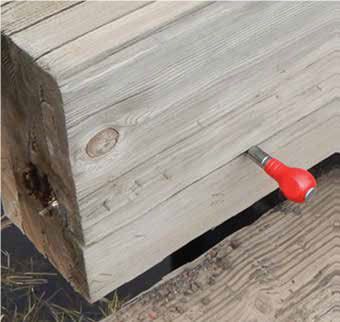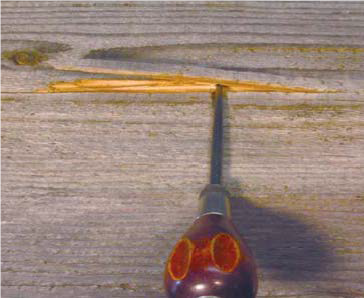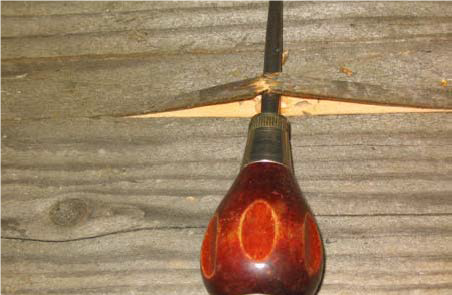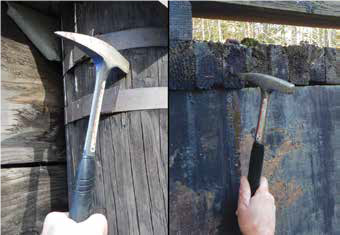Bridge - Probing
Target of investigations
Probing is beneficial in investigating the near-surface decay of wood members and estimating the depth of splits and checks—inherent defects of timber and sawn lumber.
Description
Probing involves using a moderately sharp object, such as an awl, pocketknife, or pick hammer, to locate the near-surface decay of wood members. Deteriorated wood may show excessive softness, less resistance against the probe penetration, and a different breaking pattern compared to sound wood.(1) When lifting a small sliver of wood with a pick or pocketknife, decayed wood breaks abruptly, while sound wood splinters.(2) In addition, probing with flat-bladed probes such as feeler gauges, which are typically graduated in centimeters and/or inches, can be used to estimate the depth of splits or checks in wood members.(1)

A. Decay (discoloration at the end of member) in a split of a timber member.(1)

B. Side checking in vertical substructure members (timber pile and timber column).(1)

C. Breaking pattern of sound wood.(2)

D. Breaking pattern of decayed wood.(2)

E. Probing the end-grain surface of a wood deck member.(1)
Figure 1. Photos. Methods of probing.
Physical Principle
Because wood tends to exhibit excessive softness as it deteriorates, the resistance of wood against probing with a moderately sharp object can provide information about the decay of a member. Probing can also provide information about the depth of splits and checks.
Data Acquisition
Depending on the purpose of the inspection, an awl, pocketknife, or pick hammer can be used for probing.
Data Processing
No data processing is required
Data Interpretation
Care must be taken to differentiate between water-softened wood and deteriorated wood. Probing may not be effective for assessing deterioration in low-hardness wood members such as the ones made from western red cedar.(1)
Advantages
Probing advantages include the following:
- Simplicity.
- Low cost.
- Sensitivity to the moderate and advanced level of deterioration.
Limitations
Some of the limitations of probing include the following:
- Probing is mainly sensitive to near-surface decay.
- Probing may not be an effective tool in low-hardness wood species.
- Probing does not provide quantitative information about the physical and mechanical properties of wood members.
References
- White, R. H., and R. J. Ross, eds. 2014. Wood and Timber Condition Assessment Manual. 2nd ed. General Technical Report No. FPL-GTR-234. Madison, WI: U.S. Department of Agriculture, Forest Service, Forest Products Laboratory.
- Ryan, T. W., J. E. Mann, Z. M. Chill, and B. T. Ott. 2012. FHWA Bridge Inspector’s Reference Manual (BIRM). Publication No. FHWA NHI 12-049. Washington, DC: Federal Highway Administration. https://www.fhwa.dot.gov/bridge/nbis/pubs/nhi12049.pdf, last accessed February 1, 2022.




